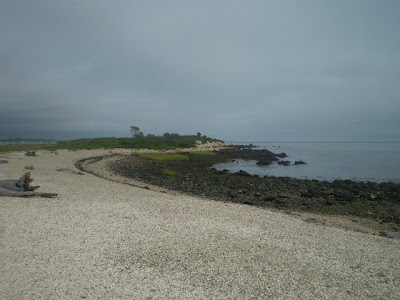by Howard Zinn
[Howard Zinn is an author and lecturer. His most noted work, from which this selection is excerpted, is "A People's History of the United States.]

Arawak men and women, naked, tawny, and full of wonder, emerged from their villages onto the island's beaches and swam out to get a closer look at the strange big boat. When Columbus and his sailors came ashore, carrying swords, speaking oddly, the Arawaks ran to greet them, brought them food, water, gifts. He later wrote of this in his log:
"They... brought us parrots and balls of cotton and spears and many other things, which they exchanged for the glass beads and hawks' bells. They willingly traded everything they owned.... They were well-built, with good bodies and handsome features.... They do not bear arms, and do not know them, for I showed them a sword, they took it by the edge and cut themselves out of ignorance. They have no iron. Their spears are made of cane.... They would make fine servants.... With fifty men we could subjugate them all and make them do whatever we want."
These Arawaks of the Bahama Islands were much like Indians on the mainland, who were remarkable (European observers were to say again and again) for their hospitality, their belief in sharing. These traits did not stand out in the Europe of the Renaissance, dominated as it was by the religion of popes, the government of kings, the frenzy for money that marked Western civilization and its first messenger to the Americas, Christopher Columbus.
Columbus wrote:
"As soon as I arrived in the Indies, on the first Island which I found, I took some of the natives by force in order that they might learn and might give me information of whatever there is in these parts." The information that Columbus wanted most was: Where is the gold?
The Indians, Columbus reported, "are so naive and so free with their possessions that no one who has not witnessed them would believe it. When you ask for something they have, they never say no. To the contrary, they offer to share with anyone...." He concluded his report by asking for a little help from their Majesties, and in return he would bring them from his next voyage "as much gold as they need . . . and as many slaves as they ask." He was full of religious talk: "Thus the eternal God, our Lord, gives victory to those who follow His way over apparent impossibilities."
Because of Columbus's exaggerated report and promises, his second expedition was given seventeen ships and more than twelve hundred men. The aim was clear: slaves and gold. They went from island to island in the Caribbean, taking Indians as captives. But as word spread of the Europeans' intent they found more and more empty villages. On Haiti, they found that the sailors left behind at Fort Navidad had been killed in a battle with the Indians, after they had roamed the island in gangs looking for gold, taking women and children as slaves for sex and labor.
Now, from his base on Haiti, Columbus sent expedition after expedition into the interior. They found no gold fields, but had to fill up the ships returning to Spain with some kind of dividend. In the year 1495, they went on a great slave raid, rounded up fifteen hundred Arawak men, women, and children, put them in pens guarded by Spaniards and dogs, then picked the five hundred best specimens to load onto ships. Of those five hundred, two hundred died en route. The rest arrived alive in Spain and were put up for sale by the archdeacon of the town, who reported that, although the slaves were "naked as the day they were born," they showed "no more embarrassment than animals." Columbus later wrote: "Let us in the name of the Holy Trinity go on sending all the slaves that can be sold."
But too many of the slaves died in captivity. And so Columbus, desperate to pay back dividends to those who had invested, had to make good his promise to fill the ships with gold. In the province of Cicao on Haiti, where he and his men imagined huge gold fields to exist, they ordered all persons fourteen years or older to collect a certain quantity of gold every three months. When they brought it, they were given copper tokens to hang around their necks. Indians found without a copper token had their hands cut off and bled to death.
The Indians had been given an impossible task. The only gold around was bits of dust garnered from the streams. So they fled, were hunted down with dogs, and were killed.
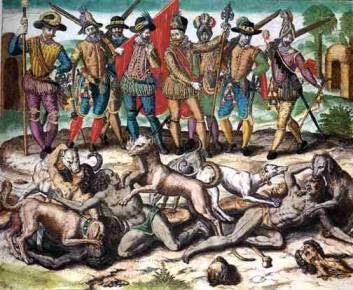
Trying to put together an army of resistance, the Arawaks faced Spaniards who had armor, muskets, swords, horses. When the Spaniards took prisoners they hanged them or burned them to death. Among the Arawaks, mass suicides began, with cassava poison. Infants were killed to save them from the Spaniards. In two years, through murder, mutilation, or suicide, half of the 250,000 Indians on Haiti were dead.
When it became clear that there was no gold left, the Indians were taken as slave labor on huge estates, known later as encomiendas. They were worked at a ferocious pace, and died by the thousands. By the year 1515, there were perhaps fifty thousand Indians left. By 1550, there were five hundred. A report of the year 1650 shows none of the original Arawaks or their descendants left on the island.
The chief source-and, on many matters the only source of information about what happened on the islands after Columbus came is Bartolome de las Casas, who, as a young priest, participated in the conquest of Cuba. For a time he owned a plantation on which Indian slaves worked, but he gave that up and became a vehement critic of Spanish cruelty. In Book Two of his History of the Indies, Las Casas (who at first urged replacing Indians by black slaves, thinking they were stronger and would survive, but later relented when he saw the effects on blacks) tells about the treatment of the Indians by the Spaniards. It is a unique account and deserves to be quoted at length: "Endless testimonies . . . prove the mild and pacific temperament of the natives.... But our work was to exasperate, ravage, kill, mangle and destroy; small wonder, then, if they tried to kill one of us now and then.... The admiral, it is true, was blind as those who came after him, and he was so anxious to please the King that he committed irreparable crimes against the Indians..."Las Casas tells how the Spaniards "grew more conceited every day" and after a while refused to walk any distance. They "rode the backs of Indians if they were in a hurry" or were carried on hammocks by Indians running in relays. "In this case they also had Indians carry large leaves to shade them from the sun and others to fan them with goose wings."
Total control led to total cruelty. The Spaniards "thought nothing of knifing Indians by tens and twenties and of cutting slices off them to test the sharpness of their blades." Las Casas tells how "two of these so-called Christians met two Indian boys one day, each carrying a parrot; they took the parrots and for fun beheaded the boys."
The Indians' attempts to defend themselves failed. And when they ran off into the hills they were found and killed. So, Las Casas reports. "they suffered and died in the mines and other labors in desperate silence, knowing not a soul in the world to whom they could tun for help." He describes their work in the mines:
"... mountains are stripped from top to bottom and bottom to top a thousand times; they dig, split rocks, move stones, and carry dirt on their backs to wash it in the rivers, while those who wash gold stay in the water all the time with their backs bent so constantly it breaks them; and when water invades the mines, the most arduous task of all is to dry the mines by scooping up pansful of water and throwing it up outside....
After each six or eight months' work in the mines, which was the time required of each crew to dig enough gold for melting, up to a third of the men died. While the men were sent many miles away to the mines, the wives remained to work the soil, forced into the excruciating job of digging and making thousands of hills for cassava plants.
Thus husbands and wives were together only once every eight or ten months and when they met they were so exhausted and depressed on both sides . . . they ceased to procreate. As for the newly born, they died early because their mothers, overworked and famished, had no milk to nurse them, and for this reason, while I was in Cuba, 7000 children died in three months. Some mothers even drowned their babies from sheer desperation.... In this way, husbands died in the mines, wives died at work, and children died from lack of milk . . . and in a short time this land which was so great, so powerful and fertile ... was depopulated.... My eyes have seen these acts so foreign to human nature, and now I tremble as I write...."
When he arrived on Hispaniola in 1508, Las Casas says, "there were 60,000 people living on this island, including the Indians; so that from 1494 to 1508, over three million people had perished from war, slavery, and the mines. Who in future generations will believe this? I myself writing it as a knowledgeable eyewitness can hardly believe it...."
Thus began the history, five hundred years ago, of the European invasion of the Indian settlements in the Americas. That beginning, when you read Las Casas--even if his figures are exaggerations (were there 3 million Indians to begin with, as he says, or less than a million, as some historians have calculated, or 8 million as others now believe?) is conquest, slavery, death. When we read the history books given to children in the United States, it all starts with heroic adventure--there is no bloodshed-and Columbus Day is a celebration.
The treatment of heroes (Columbus) and their victims (the Arawaks) the quiet acceptance of conquest and murder in the name of progress-is only one aspect of a certain approach to history, in which the past is told from the point of view of governments, conquerors, diplomats, leaders. It is as if they, like Columbus, deserve universal acceptance, as if they-the Founding Fathers, Jackson, Lincoln, Wilson, Roosevelt, Kennedy, the leading members of Congress, the famous Justices of the Supreme Court-represent the nation as a whole. The pretense is that there really is such a thing as "the United States," subject to occasional conflicts and quarrels, but fundamentally a community of people with common interests. It is as if there really is a "national interest" represented in the Constitution, in territorial expansion, in the laws passed by Congress, the decisions of the courts, the development of capitalism, the culture of education and the mass media.




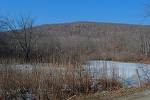

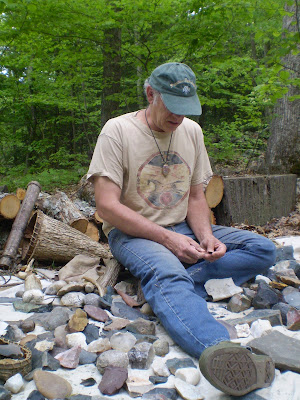
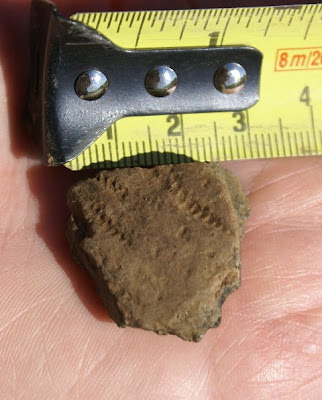























 Closer:
Closer: That is Poison Ivy.
That is Poison Ivy.


